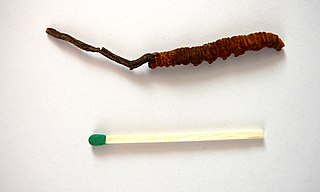
Ophiocordyceps sinensis, known colloquially as caterpillar fungus, is an entomopathogenic fungus in the family Ophiocordycipitaceae. It is mainly found in the meadows above 3,500 metres (11,500 ft) on the Tibetan Plateau in Tibet and the Himalayan regions of Bhutan, India, and Nepal. It parasitizes larvae of ghost moths and produces a fruiting body which is valued in traditional Chinese medicine as an aphrodisiac. Caterpillar fungus contains the compound cordycepin, an adenosine derivative. However, the fruiting bodies harvested in nature usually contain high amounts of arsenic and other heavy metals, so they are potentially toxic and sales have been strictly regulated by China's State Administration for Market Regulation since 2016.
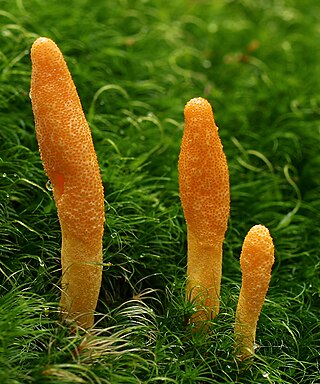
Cordyceps is a genus of ascomycete fungi that includes about 600 worldwide species. Diverse variants of cordyceps have had more than 1,500 years of use in Chinese medicine. Most Cordyceps species are endoparasitoids, parasitic mainly on insects and other arthropods ; a few are parasitic on other fungi.
Tolypocladium inflatum is an ascomycete fungus originally isolated from a Norwegian soil sample that, under certain conditions, produces the immunosuppressant drug ciclosporin. In its sexual stage (teleomorph) it is a parasite on scarab beetles. It forms a small, compound ascocarp that arises from the cadaver of its host beetle. In its asexual stage (anamorph) it is a white mold that grows on soil. It is much more commonly found in its asexual stage and this is the stage that was originally given the name Tolypocladium inflatum.

Epichloë is a genus of ascomycete fungi forming an endophytic symbiosis with grasses. Grass choke disease is a symptom in grasses induced by some Epichloë species, which form spore-bearing mats (stromata) on tillers and suppress the development of their host plant's inflorescence. For most of their life cycle however, Epichloë grow in the intercellular space of stems, leaves, inflorescences, and seeds of the grass plant without incurring symptoms of disease. In fact, they provide several benefits to their host, including the production of different herbivore-deterring alkaloids, increased stress resistance, and growth promotion.
Hyphomycetes are a form classification of fungi, part of what has often been referred to as fungi imperfecti, Deuteromycota, or anamorphic fungi. Hyphomycetes lack closed fruit bodies, and are often referred to as moulds. Most hyphomycetes are now assigned to the Ascomycota, on the basis of genetic connections made by life-cycle studies or by phylogenetic analysis of DNA sequences; many remain unassigned phylogenetically.

Beauveria is a genus of asexually-reproducing fungi allied with the ascomycete family Cordycipitaceae. Its several species are typically insect pathogens. The sexual states (teleomorphs) of Beauveria species, where known, are species of Cordyceps.
Hirsutella is a genus of asexually reproducing fungi in the Ophiocordycipitaceae family. Originally described by French mycologist Narcisse Théophile Patouillard in 1892, this genus includes species that are pathogens of insects, mites and nematodes; there is interest in the use of these fungi as biological controls of insect and nematode pests. The teleomorphs of Hirsutella species are thought to belong to the genus Ophiocordyceps.
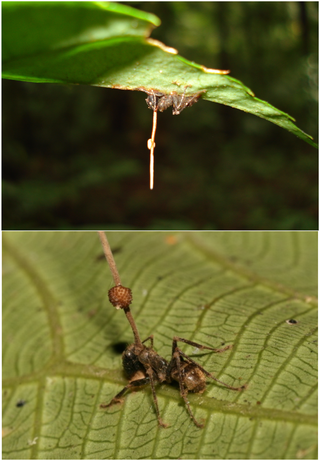
Ophiocordycipitaceae is a family of parasitic fungi in the Ascomycota, class Sordariomycetes. It was updated in 2020.

Ophiocordyceps is a genus of fungi within the family Ophiocordycipitaceae. The widespread genus, first described scientifically by British mycologist Tom Petch in 1931, contains about 140 species that grow on insects. Anamorphic genera that correspond with Ophiocordyceps species are Hirsutella, Hymenostilbe, Isaria, Paraisaria, and Syngliocladium.
Podonectria is a genus in the monotypic Podonectriaceae family of fungi. They are parasitic fungus on scale insects, other fungi, or on substrates that had previously colonized by other fungi.

Rhizoctonia is a genus of fungi in the order Cantharellales. Species form thin, effused, corticioid basidiocarps, but are most frequently found in their sterile, anamorphic state. Rhizoctonia species are saprotrophic, but some are also facultative plant pathogens, causing commercially important crop diseases. Some are also endomycorrhizal associates of orchids. The genus name was formerly used to accommodate many superficially similar, but unrelated fungi.
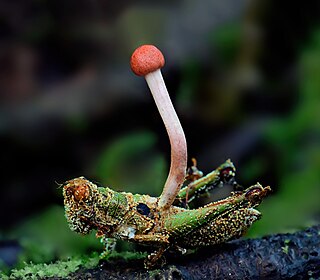
Paraisaria is a genus of fungi in the Ophiocordycipitaceae family. Members are anamorph names of Ophiocordyceps.
Syngliocladium is a genus of anamorphic fungi within the Ophiocordycipitaceae family. Members are anamorph names of Ophiocordyceps.
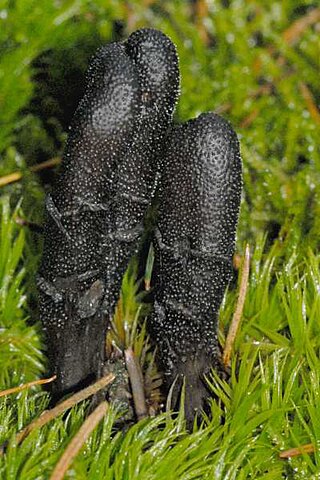
Tolypocladium ophioglossoides, also known by two of its better known synonyms Elaphocordyceps ophioglossoides and Cordyceps ophioglossoides and commonly known as the goldenthread cordyceps, is a species of fungus in the family Ophiocordycipitaceae. It is parasitic on fruit bodies of the truffle-like Elaphomyces. The species is considered inedible, but is valued in traditional Chinese medicine.

Cordyceps militaris is a species of fungus in the family Cordycipitaceae, and the type species of the genus Cordyceps, which consists of hundreds of species. The species was originally described by Carl Linnaeus in 1753 as Clavaria militaris. Cordyceps militaris parasitizes insects and is used use in traditional Chinese medicine and modern pharmaceuticals.

The Cordycipitaceae are a family of parasitic fungi in the Ascomycota, class Sordariomycetes and order Hypocreales. The family was first published in 1969 by mycologist Hanns Kreisel, but the naming was invalid according to the code of International Code of Nomenclature for algae, fungi, and plants. It was validly published in 2007.

Ophiocordyceps formicarum is an entomopathogenic fungus belonging to the order Hypocreales (Ascomycota) in the family Ophiocordycipitaceae. The fungus was first described by mycologist George S. Kobayashi in 1939 as a species of Cordyceps. Originally found in Japan growing on an adult Hercules ant, it was reported from Guizhou, China, in 2003. It was transferred to the new genus Ophiocordyceps in 2007 when the family Cordycipitaceae was reorganized. A technique has been developed to grow the fungus in an agar growth medium supplemented with yeast extract, inosine, and glucose.
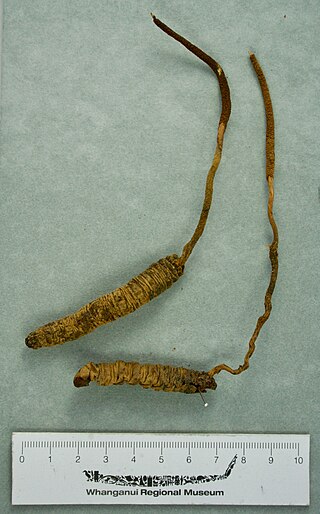
Ophiocordyceps robertsii, known in New Zealand as vegetable caterpillar is an entomopathogenic fungus belonging to the order Hypocreales (Ascomycota) in the family Ophiocordycipitaceae. It invades the caterpillars of leaf-litter dwelling moths and turns them into fungal mummies, sending up a fruiting spike above the forest floor to shed its spores. Caterpillars eat the spores whilst feeding on leaf litter to complete the fungal life cycle. Evidence of this fungus can be seen when small brown stems push through the forest floor: underneath will be the dried remains of the host caterpillar. This species was first thought by Europeans to be a worm or caterpillar that burrowed from the top of a tree to the roots, where it exited and then grew a shoot of the plant out of its head. It was the first fungus provided with a binomial name from New Zealand.

Cordyceps gunni is a species of fungus in the family Cordycipitaceae, and is of the genus Cordyceps. It was originally found and recorded by Gunn in Tasmania and named as Sphaeria gunnii and later moved into the Cordyceps genus and renamed Cordyceps gunnii. This fungus and its sisters in the genus Cordyceps are known for growing out of insect bodies. C. gunnii can be found at ground level poking out of caterpillar burrows, attached to a caterpillar's head.

Ophiocordyceps dipterigena is an entomopathogenic fungi species from the genus Ophiocordyceps. This species was originally described in 2007.












